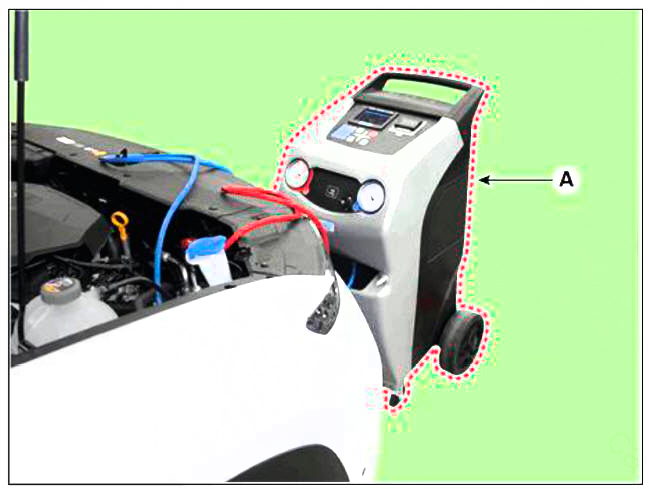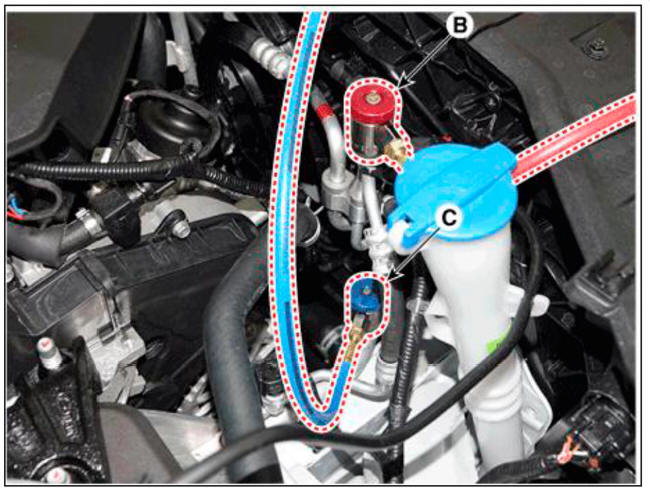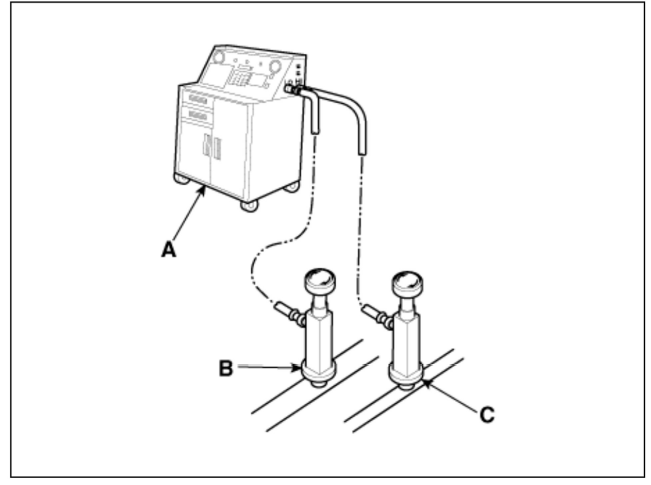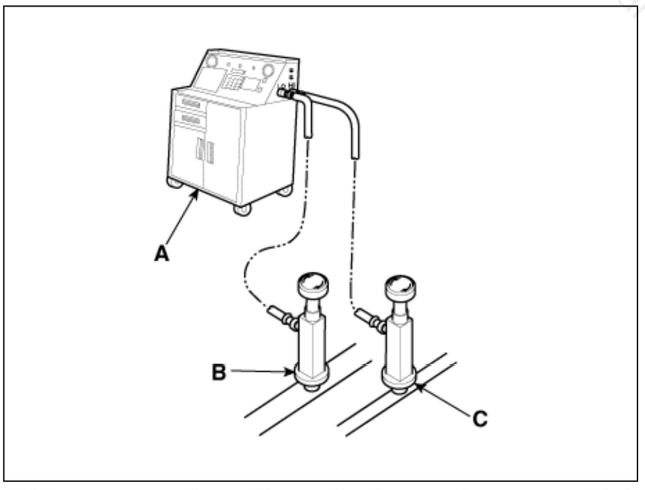Hyundai Tucson: Refrigerant System Service Basics (R- 1234yf)
Refrigerant Identification
- Do not mix HFO-1234yf (R-1234yf) in the vehicle with other refrigerant, such as R-12. R-134a and etc.
- Use only service equipment that is U.L-listed and is certified to meet the requirements of SAE standards to recover and recycle R-1234yf from the air conditioning system. Do not use service equipment for the other refrigerant, such as R-12, R-134a and etc.
- Verify what refrigerant is in the system if there is concern that the system has been tampered with in any way and check the type and quantity of refrigerant that shall be in the A/C system and potential issues arising from accidental or intentional mixing of refrigerants.
- Using an SAE certified refrigerant identification device is recommended to prevent improper recovery and the resulting further spread of contaminated refrigerant, which could potentially damage other A/C systems and service equipment. Contaminated refrigerant (blend of more than one refrigerant or non-system refrigerant) in recovery/recycling equipment could lead to the potential contamination of more refrigerant.
- Certain types of electronic leak detection devices (heated diode or corona discharge) as well as motors, switches, and controls on recovery and recycling machines, could generate sparks that could serve as ignition sources in the presence of refrigerants classified as flammable (A2 or A3) by ASHRAE standard 34 2006.
- It is possible that the mixing of refrigerants in a A/C system can result in higher-than-expected system pressures, system and component damage, diagnostic errors and/or other potential hazards to people and environment.
- In case other refrigerant is mixed, recover the contaminated refrigerant in the A/C system and dispose it in accordance with all applicable national, regional or local regulations. Clean inside the A/C system using the specialized detergent and recharge new refrigerant.
Refrigerant Recovery
Use only service equipment that is U.L-listed and is certified to meet the requirements of SAE standards to remove HFO-1234yf (R-1234yf) from the air conditioning system.
WARNING
- Air conditioning refrigerant or lubricant vapor can irritate your eyes, nose, or throat.
- Be careful when connecting service equipment.
- Do not breathe refrigerant or vapor.
If accidental system discharge occurs, ventilate work area before resume of service.
Additional health and safety information may be obtained from the refrigerant and lubricant manufacturers.
- Connect an R-1234yf refrigerant Recoveiy / Recycling / Charging System (A) to the high-pressure service port (B) and the low-pressure service port (C) as shown, following the equipment


- Measure the amount of refrigerant oil removed from the A/C system after the recovery process is completed. Be sure to install the same amount of new refrigerant oil back into the A/C system before charging.
System Evacuation
Use only service equipment that is U.L-listed and is certified to meet the requirements of SAE standards to remove HFO-1234yf (R-1234yf) from the air conditioning system.
WARNING
- Air conditioning refrigerant or lubricant vapor can irritate your eyes, nose, or throat.
- Be careful when connecting service equipment.
- Do not breathe refrigerant or vapor.
If accidental system discharge occurs, ventilate work area before resume of service.
Additional health and safety information may be obtained from the refrigerant and lubricant manufacturers.
- When an A/C System has been opened to the atmosphere, such as during installation or repair, it must be evacuated using an R-1234yf refrigerant Recovery/Recycling/Charging System. (If the system has been open for several days, the receiver/dryer should be replaced, and the system should be evacuated for several hours.)
- Connect an R-1234yf refrigerant
Recovery /Recycling/Charging System (A) to the high-pressure service port (B) and the lowpressure service port (C) as shown, following the equipment manufacturer's instructions.

- If the low-pressure does not reach more than 87.7 kPa (658 mmHg, 25.9 in.Hg) in 5 minutes, there is probably a leak in the system. Partially charge the system, and check for leaks (see "Refrigerant Leak Test").
- Remove the low pressure valve from the low-pressure service port.
System Charging
Use only service equipment that is U.L-listed and is certified to meet the requirements of SAE standards to remove HFO-1234yf (R-1234yf) from the air conditioning system.
WARNING
- Air conditioning refrigerant or lubricant vapor can irritate your eyes, nose, or throat.
- Be careful when connecting service equipment.
- Do not breathe refrigerant or vapor.
If accidental system discharge occurs, ventilate work area before resume of service.
Additional health and safety information may be obtained from the refrigerant and lubricant manufacturers.
- Connect an R-1234yf refrigerant
Recovery /Recycling/Charging System (A) to the high-pressure service port (B) as shown, following the equipment manufacturer's instructions.

- Add the same amount of new refrigerant oil to the system that was removed during recovery. Use only specified refrigerant oil. Charge the system with 550 +- 25g (17.68+-0.88oz) R-1234yf refrigerant. Do not overcharge the system the compressor will be damaged.
Refrigerant Leak Test
Always conduct a leak test with an electronic leak detector whenever leakage or refrigerant is suspected and when conducting service operations which are accompanied by disassembly or loosening or connection fittings.
WARNING
In order to use the leak detector properly, read the manual supplied by the manufacturer.
WARNING
Use only leak detection devices certified to SAE standards for use with R-1234yf. Certain leak detection devices (heated diode or corona discharge) could serve as ignition sources in the presence of hydrocarbons or other flammable refrigerants.
If a gas leak is detected, proceed as follows :
- Check the torque on the connection fittings and, if too loose, tighten to the proper torque. Check for gas leakage with a leak detector (A).
- If leakage continues even after the fitting has been tightened, discharge the refrigerant from the system, disconnect the fittings, and check their seating faces for damage. Always replace, even if the damage is slight.
- Check the compressor oil and add oil if required.
- Charge the system and recheck for gas leaks. If no leaks are found, evacuate and charge the system again.

Oil - Specification
- The R-134a or R-1234yf system requires synthetic (PAG) compressor oil whereas the R-12 system requires mineral compressor oil. The two oils must never be mixed.
- Compressor (PAG) oil varies according to compressor model. Be sure to use oil specified for the model of compressor.
Handling of Oil
- The oil should be free from moisture, dust, metal powder, etc.
- Do not mix with other oil.
- The water content in the oil increases when exposed to air. After use, seal oil from air immediately. (R- 134a or R-1234yf Compressor Oil absorbs moisture veiy easily.)
- The compressor oil must be stored in steel containers, not in plastic containers.
Compressor Oil Check
The oil used to lubricate the compressor circulates with the refrigerant.
Whenever replacing any component of the system or a large amount of gas leakage occurs, add oil to maintain the original amount of oil.
Oil total volume in system : PAG 30 : 120 +- lOcc (3.85 +- 0.3 oz.)
Oil Return Operation
There is close affinity between the oil and refrigerant.
During normal operation, part of the oil recirculates with the refrigerant in the system. When checking the amount of oil in the system, or replacing any component of the system, the compressor must ran in advance for oil return operation. The procedure is as follows :
- Open all the doors and engine hood.
- Start the engine and air conditioning switch to "ON" and set the blower motor control knob at its highest position.
- Run the compressor for more than 20 minutes between 800 and 1,000 rpm in order to operate the system.
- Stop the engine.
READ NEXT:
 Suction & Liquid Pipe Assembly
Suction & Liquid Pipe Assembly
Components
Suction & Liquid Pipe Assembly
Replacement
If a compressor is available, the air conditioner is operated for a few
minutes in the engine idle state and then
the engine is stopped.
Disconnect the negative (-) batte
 Compressor
Compressor
Components
Compressor
Components
Clutch bolt
Disc & Hub assembly
Snap ring (Rotor)
Pulley
Snap Ring (Stator)
Clutch spacer
Compressor
Electric Control Valve (ECV)
Electric Control Valve (ECV) snap ring
Removal
 Compressor - Installation
Compressor - Installation
Make sure that the compressor (A) mounting bolt of the correct length is
screwed in. Tighten the mounting bolts in the
specified tightening order.
Install in the reverse order of removal.
f you install a new compressor, drain
SEE MORE:
 Clutch actuator assembly - Components
Clutch actuator assembly - Components
Components
Fork cover
Clutch actuator & TCM assembly
Clutch actuator assembly
O-ring
DCT control module (TCM)
Specification
Removal
Turn ignition switch OFF and disconnect the battery negative (-)
terminal.
Remove
 Body Control Module Controls The Followings
Body Control Module Controls The Followings
Description
Body Control Module Controls The Followings
Wiper & Washer Control
Defroster Control
Driving Control
Tailgate Control
Window Control
Interior Control
Exterior Control
Panic alarm Control
MTS
Flasher output Contr
Information
- Home
- Hyundai Tucson - Fourth generation (NX4) - (2020-2023) - Owner's Manual
- Hyundai Tucson - Fourth generation (NX4) - (2020-2023) - Workshop Manual